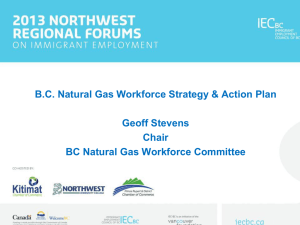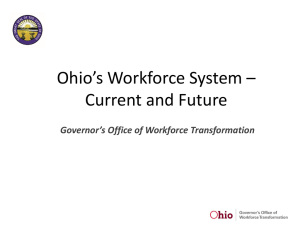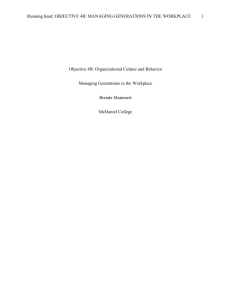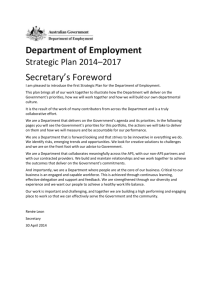Flexibility and Business Performance
advertisement
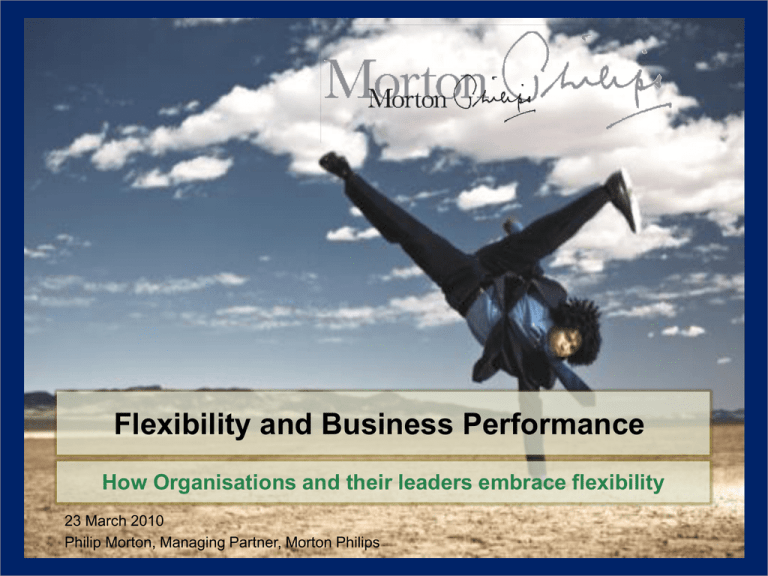
Flexibility and Business Performance How Organisations and their leaders embrace flexibility 23 March 2010 Philip Morton, Managing Partner, Morton Philips What will we be talking about today? ● The dramatic changes to the places of work, work practices and employee expectations. ● How an organisation and its leaders can embrace flexibility AND still deliver outstanding performance? ● What does the future look like for business leaders? Topics covered People don't want to work less. They want to work differently Setting the scene..... What's happened in the workforce and how has the work place changed in the last 10 years? Australia has enjoyed ● Almost a decade and a half of uninterrupted economic growth and historically strong labour market conditions. ● Unemployment is at its lowest in nearly 30 years However... ● An ageing population which will impact on labour force growth ● New set of expectations about work life situations ● National skill shortages – over the next 5 years the estimated impact of population is an equivalent shortfall to 195,000 ● A booming 24/7 global economy For the first time in Australian History there will soon be fewer people entering the workforce than leaving it i.e. a dearth of human capital Some facts.... Good news.... According to findings in the CFO Perceptions of Work Life Flexibility Study by Cali Williams Yost the CEO and cofounder of Work + Life + Fit Inc who did a random survey on US’s top CFOs ● A majority of CFOs recognized a broad range of potential bottom line impacts that flexibility could achieve, including recruitment and retention; improved employee productivity; differentiation from competitors; minimizing environmental impact and reducing health care cost. Bad news.... ● Only 13 out of the 100 had a formal approach to flexibility in place and had a senior leadership team that perceived it to be a strategy for managing work, resources and talent. ● I.e. only 13% of the CFOs worked for organizations with the leadership understanding and organizational infrastructure to translate that awareness into action for bottom line results. ● The remaining 87 CFOs, or 87%, had no formal approach to flexibility in place and/or had a leadership team that saw flexibility as an informal “perk.” Not a powerful recipe for seeing and executing flexibility as a strategic lever. ● “Estimate 85% of all workforce growth will be supplied by people aged 45+ by 2012 up from 32% in 1992. this is a phenomenal shift in just 20 years demonstrating how fast the population is ageing” ● Labour shortages were still 5 years away, of the 475 firms interviewed 66% of them said they were experiencing difficulties filling jobs ● 73% of office workers believe that they would be more productive if they worked from home (online poll ISP Lumison, London) ● 65% claim to work longer hours at home Employee generations What are the different generations? ● Originally thought of as having a 20year age gap but social change in educational opportunities, delayed marriage, rate of technological change etc has led to a blending at the cusp of the generations Matures ● Born pre 1946 ● They experienced economic upheaval during childhood. ● Discipline and self-sacrifice were cornerstones of their out-look as they came of age. ● Common goals like overcoming the Great Depression and building suburban America, and also by the necessity to defeat common enemies - Germany and Japan, then the Soviet Union and China. Baby boomers ● Born 1946-1964 ● not a homogenous grouping, consist of a number of subsets: span an age range from 64-46. ● Large number now retiring or have already retired from 50 onwards. Many could live to be 90 or more. ● Raised in a time of phenomenal national wealth, they expanded the economy more than any other generation. ● They challenge hierarchies, communicate and share responsibilities freely Employee generations Generation X ● Born 1965-1980 ● Accept diversity; they are skeptical, pragmatic and practical, self-reliant, independent and individualistic; ● They reject authoritarianism and control; they were latchkey children and separate friends from family. ● They like a casual, friendly work environment, seek challenge, involvement and flexible learning arrangements. ● Work-life balance and family priorities are very important to Gen Xers. Generation Y (Millennial Generation or Generation Next or Net Generation) ● Born1981-1999 ● celebrate diversity; they are optimistic, inventive and individualistic; they rewrite the rules; ● they enjoy a pleasurable lifestyle; they don't see the relevance of most institutions; ● they are masters of technology and social media; ● were nurtured by their parents; see friends as family; like a collaborative supportive work environment and interactive work relationships; ● have high demands and expectations; want to work for companies that are socially responsible and they want a balanced life. What will Generation “Z” be like?? What is meant by flexibility? Some definitions you are likely to hear ● Flexitime ● Hoteling ● Job sharing ● Part time employment ● Phased retirement ● Phased return from leave ● Telecommuting/ telework ● Virtual work How as an organisation can you keep up and still deliver outstanding performance? Develop a proactive strategy Include● Attract and retain the new generation and the previous generations ● Assess policies and practices ● Adequate supervision and controls ● Differential performance reviews ● Job redesign ● Coaching and Counselling Seven tips to maximising the effectiveness of your strategy: 1 Make the link to business goals 2 Review the current state 3 Be flexible with flexibility 4 Enlist managers 5 Communicate, communicate, communicate! 6 Think business results 7 Sell up! What do you need to consider with your strategy? To successfully implement flexible work practice you need a systematic culture change approach ● Start with Work/Life Audit to ascertain what practices are working ● Develop strategies to overcome the challenges include creating ● Develop an organisation specific business case ● Engage managers and employees in the process ● Address management issues ● Train managers in how to manage flexible work practices ● Evaluate the success of the program ● Begin with a pilot program with a team of people committed to making workplace flexibility a success Examples of what other companies are doing... As generation Y plays a greater part in the workforce strategies need to be in place to establish the work/life balance of the company For example ● Revolving door policy – keep the door open to younger staff who leave to experience other companies and life situations ● Provide introductions for overseas work and facilitate them, keeping the relationship going until they return (Malleson Stephens Jacques a leading Australian law firm) ● Double parental leave entitlements (rates for return to work for ANZ have gone up from 78 to 93% within the last few years) ● Guaranteed part time work for staff over 55 – allowing staff to have a downshift, a career extension as a right – this resulted in a rise of average retirement from 55 in 2001 to 58 in 2005 (ANZ) Advantages and disadvantages of flexible working practices to EMPLOYEES EMPLOYEES... Advantages Disadvantages ● Better health ● Cost – disadvantage or advantage? ● Less stress ● Working at home with children? ● A sense of control after making a proactive decision ● Isolation ● Better quality of life ● Lack of supervision ● Coping better with non-work responsibilities ● Lower salary if you work fewer hours ● Retaining earning capability ● Need for a dedicated work space ● Less commuting/cheaper transport costs ● More effective time management ● Choice of working patterns ● Good for children ● Good for equality ● Difficulty in judging performance ● Need to be self disciplined and highly organised ● Possible obstacle to promotion ● A sense that you have been forced into it by circumstances not of your choosing Advantages and disadvantages of flexible working practices to EMPLOYEES EMPLOYERS... Advantages Disadvantages ● Increased retention ● Difficulty of managing home workers and monitoring performance ● Higher engagement and productivity ● Enhanced recruiting and competitive position ● Reputation as an “employer of choice” ● Improved scheduling and coverage across time zones and continents ● Reduction of the company’s carbon footprint ● Deterioration in employees skills and work quality ● Initial costs of training and providing suitable equipment including adaptations to meet health and safety standards ● Maintaining staff development and upgrading skills ● Risk of information security problems ● Increased telecommunication costs ● Risk of communication problems and a sense of isolation amongst home workers ● Can be harder to maintain team spirit ● Working from home is unsuitable for some types of jobs What does the future look like? Future of working practices – what are companies doing now? Many companies still do not embrace the concept of flexible working and according to a survey by ISP Lumison, London who surveyed 1,013 people earlier this year, the break down of obstacles to working from home were the following: A note about potential security issues.... Businesses may be putting themselves at risk by allowing staff to work at home without proper security ● Problem is that most businesses have neglected security in pursuit of better business continuity ● They have neglected to think about the security implications of having data stored in more locations than ever before Five tips for businesses on implementing remote working technology Here are 5 tips for businesses on remote working technology 1 Cost-benefit analysis 2 Staff consultation 3 Remote working security policy 4 Flexible working policy 5 Training What is the government doing to help? ● Provision of additional child-care places for parents of school-age children, including Outside School Hours Care ● Targeted and improved industry and workplace engagement strategies ● Strategies to increase employment of workers with a disability ● Training for employers to manage an ageing workforce effectively ● Additional training and employment preparation services for job seekers 10 ways Generation Y will change the workplace 1. More Productive Meetings 2. Shorten the traditional working day 3. Bring back administrative assistants 4. Redefine retirement 5. Find real mentors 6. Restore respect to the HR department 7. Promote based on emotional intelligence 8. Continue to value what our parents had to offer 9. Enjoy higher starting salaries 10. Reinvent the performance review Roadblocks to success If its such a win win situation why aren't more employers embracing flexibility? Several roadblocks keep employers from making the connection. ● Biggest is long standing work place norms ● Many cultures are still rooted in the industrial age and focus on hours and ‘face to face’ time ● Rather than hours worked we use hours worked specifically hours in the office to measure performance ● Manager attitudes – most managers have primary if not sole responsibility for making flex work a reality ● Nearly two thirds of managers have had no formal training on flexibility for managers ● Senior leaders – most do not see the connection between flexibility and quantifiable business results and see the programs as “soft” ● Poor execution – employees need to understand what is offered and have a clear expectation of their role and responsibilities As a result, it is very difficult to change the above and does nothing to encourage flexible work practice If you don't embrace the change what will happen? As labour forces in Australia and globally shrink, employers will need to be innovative about attracting the shrinking supply of available talent – in short if you don't do anything there is a very real danger that your company will face possible extinction ● Gone are the days of treating everyone the same ● Employees have different needs, expectations and preferences ● A one size fits all approach does not work in today's changing work landscape If you don't embrace these concepts you will lose the competitive advantage of employing a more aligned, engaged and productive workforce Conclusion ● The workforce of the future will be more diverse it will consist of more older workers, more parents, and more people wanting to work parttime so new strategies will be needed ● Organisations interested in creating a flexible work environment have a variety of options available to them. ● It is really a matter of tailoring the specific type(s) of flexibility to employee needs, the constraints of specific jobs, and the organisation’s culture and structure. ● Work flexibility practices can relate to other types of psychologically healthy workplace programs and practices. ● Organisational decision makers themselves have a lot of flexibility in how they choose to utilise flexible work arrangements. Questions and answers Level 9, Western End MTAA Super Building 55 Currie Street Adelaide SA 5000 Australia T +61 8 8210 8510 F +61 8 8210 8500 E operations@mortonphilips.com.au W www.mortonphilips.com.au




